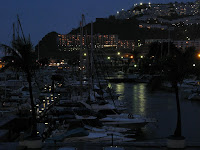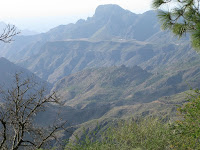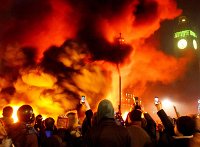Donna and I enjoyed a week in Gran Canaria. It was unexpectedly extended by two days as a result of a strike by Spanish air traffic controllers! The weather was variable, but warm, we loved our hotel, and there was plenty to see and do.(You can click the images for larger versions and there's a separate
picture gallery with more photos. Hint: from the gallery you can use the slideshow button at top-right.)
 Day One - 27th November
Day One - 27th November - We flew out from
Birmingham Airport. The four and a half hour flight was uneventful with views of the frozen English countryside on the way followed by cloudy conditions for the most of the journey. We did have some clear views of the lights on the south-east coast of the island as we approached the airport.
It was wonderful to leave the plane and feel the warm climate. We looked forward to a week of pleasant weather, no shivering, and no need for more than shorts and T-shirt.
Day Two - 28th November - We were staying at
Marina Suites in the town of
Puerto Rico. When we looked out of our window in the morning there were large puddles everywhere and the sky was grey. It was warm, but jeans and a fleece seemed more appropriate than the expected shorts and T-shirt!

We weren't too troubled, we wanted to rest after our journey so we spent most of our time exploring the hotel and the local area (including the Marina), reading, and visiting the local supermarket to stock up with food.
The self-catering apartment where we were staying had a fridge and simple cooking facilities. A nice cup of tea came quite high on our list of priorities.
Day Three - 29th November - We had some torrential rain today, and I do mean absolutely
torrential. Stall holders were racing to get their stock inside, cars were throwing up walls of water as they drove by, and we were completely stuck in the little holiday shop where we had been when the rain began.

Fortunately the rain came as showers so after half an hour or so we were able to head back to the apartment before the next one hit. Puerto Rico is built around a ravine which is completely dry most of the year in this sem-desert climate. But it quickly became a very active little river again following the heavy rain.
Back at the apartment we returned to reading and chilling out, much easier now as we had bought two mugs in the town. Cups are way too small for a decent brew of tea.
As night fell the weather improved and the view from the balcony was beautiful with sparkling lights reflected in the water.
Day Four - 30th November - The weather began to improve markedly today. We had plenty of bright sunshine but there were still some heavy clouds around sweeping in across the ocean from the south-west.

The picture shows the arid hills with holiday homes and hotels and their irrigated trees (the natural coastal vegetation is scrubby bush with large bare areas of baked rock and stone).
We were able to explore the local area more thoroughly on foot today. We arranged to hire a car for the remainder of our stay so that we could explore a bit further afield.
Day Five - 1st December - I picked up the car first thing in the morning and then drove back to the hotel to collect Donna.

We had decided to head inland and visit the mountains. Although the coastal parts of Gran Canaria are used mainly for tourism, the inland parts have a more temperate and moist climate and are used mainly for agriculture.
We headed south-east along the coast to
Maspalomas and then used the GC-60 north to the centre of the island. The rock and scrub gradually changed to Opuntia and dry grass, then eventually to occasional palms and finally pine trees.

On the way we passed the small settlements of Artedara, Fataga, and eventually San Bartolomé de Tirajana where we stopped for lunch (
Canarian potatoes are very good!). Little in the way of tourist hotels here, and there are some genuinely old, Spanish buildings.

These are absolutely beautiful places and we saw some lovely mountain scenery.
Heading on again we visited the cross at Tejeda and then drove to the highest point on the island,
Pico de Las Nieves (1949 m above sea level).

The views from here were awesome as we were above the cloud tops and could see Mount Teide on the neighbouring island of Tenerife, about 125 km away!
The journey back home took us east on the GC-130 and GC-120 through Pasadilla and then the GC-196 back to the east coast motorway (the GC-1). There were more spectacular views on the way.
To be continued...
 The Big Picture has some clear images of the trouble. Both protesters and police suffered some injuries and there will be inquiries to clarify how these happened.
The Big Picture has some clear images of the trouble. Both protesters and police suffered some injuries and there will be inquiries to clarify how these happened.












